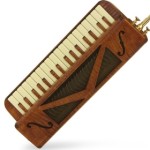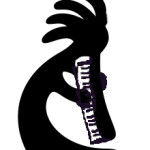My dream melodica
Tagged: Melodica Design
- This topic has 24 replies, 9 voices, and was last updated 8 years, 10 months ago by
 Alan Brinton.
Alan Brinton.
-
AuthorPosts
-
April 25, 2015 at 9:30 pm #4825
 OfirParticipant
OfirParticipantQuetscher, your suggestion of a focus point is great. However, I’m not sure that I share your desired focus.
My dream instrument (and I believe that Daren’s as well) is a fine sounding, very responsive and yet lightweight; in a way, possibly the vintage Pro 36 (or your beloved Vibrandoneon) redesigned by Yamaha’s P37D engineers. For that matter, bending and everything that is unorthodox for a piano (and accordion) is probably out of the scope.
On the other hand, pitch bending and sound articulation modifying seem like strong requirements calling for a totally different approach. Therefore, there are possibly two very different dream instruments on the line, and we should not mix them.
Luckily, seems like Daren (which runs the practical aspect of this effort) is on my side.. 🙂
April 26, 2015 at 2:40 am #4827Binyomin
ParticipantGreat topic.
I too am partial to the sound of the vibrandoneon (which I have) and the Clavietta (which I had at one point). The Hammond 44 HP (which I also have) is also in the same ballpark tone-wise. For me, my dream instrument would hit that sweet spot between accordion and harmonica in tone, with the richness of a warm accordion sound, and the presence of a good harmonica.
BTW, Ofir, bending is an integral part of accordion playing in some cultures like the Roma.
As well, for me the instrument should be neither too light nor too heavy. I want it to feel substantial in my hand, when I play it, but at the same time, have it be balanced nicely.
Great topic!
April 26, 2015 at 6:17 am #4828 Melodica-MeParticipant
Melodica-MeParticipantIf we were to narrow down the perfect Melodica or Dream Melodica to only two things, I guess I would have to say the sound of the Vibrandoneon single reeds and the body of the Hammond Hyper. I love these two instruments.
Melodica-MeApril 26, 2015 at 10:24 am #4829 LowboyParticipant
LowboyParticipantIf piano players could bend notes, surely they would.
In fact, many piano players try to imply note bending by decorating the notes they play. Hammond organists have learned to shut of the tone generator for a second or two to slow it down and bend notes. Synth players have pitch control wheels. And in the land of free reeds, bending makes the harmonica what it is, the most popular musical instrument of all time I do believe. It goes without saying that bending is an integral part of playing sax, guitar, and dozens of other popular instruments.
If piano players could bend notes, surely they would.
Lowboy
April 26, 2015 at 10:57 am #4830 LowboyParticipant
LowboyParticipantEven hand drummers bend notes.
My point is, bending brings instruments and musical passages alive and provides great opportunity for real expression, along the lines of the human voice, the greatest of the musical instruments. (Vocalists use note bending to great effect too come to think if it.)
Bending is so important to musical expression, that many instruments incorporate bending capability into their design, and if they don’t, people go to great lengths to develop techniques to make their instruments bend notes.
I think it would be essential to consider note bending in the conceptual design of any instrument.
Lowboy
April 26, 2015 at 6:19 pm #4831 QuetscherParticipant
QuetscherParticipantFirst of all I’d like to make clear my point of view: the melodica is BOTH a keyboard and a wind instrument – I didn’t want to put MORE focus on the wind instrument side, I simply wanted to avoid this side to be neglected, The strength of the melodica is not that it is a better keyboard instrument than others (I would always prefer the accordion to a melodica) and it’s not that it’s a better wind instrument (nearly most wind instruments are much more flexible), its real strength is the combination of both. So let’s work on both aspects!
Second: as we talk of “dream” melodicas, I’d say it’s allowed to dream of everything! I’m looking forward to seeing which ideas will come true, but for now I like each idea that occurs!
Third: if there is a way to ease bendings (BTW, Lowboy, thanks a lot for your remarks about bendings!) and modify sound in an instrument that is constructed melodica-style, I’d be glad! It’s not that I prefer accordion-style instruments to melodica-style instruments, I simply didn’t see the solutions to certain problems in melodica-style construction by now
April 29, 2015 at 3:46 pm #4889 KevinParticipant
KevinParticipantI wanted to jump in on this as it’s a subject I’ve been thinking of for a long time.
My dream melodica involves tuning, tuning, tuning.
I don’t think anyone has mentioned individual reeds, I think this would be preferable for tuning and maintenance.
Also it would allow the player to try different timbres by being able to switch out different sets of reeds in the same instrument steel for bronze etc. or even a mixes, steel in the low notes for clarity bronze in the upper register for warmth etc.What I’d really like to see is a way to access tuning without disassembling the entire instrument!
(A process I’ve found to be so frustrating and unrewarding I’ve all but given up playing the things.)
A harmonica can be tuned by only removing the cover. Likewise a reed organ(I’m not familiar with accordion maintenance) the advantage being you can immediately check your progress and the act of assembly/disassembly doesn’t affect the results.
This would probably require a re-imaging of the fundamental functioning of the instrument as far as how air flows?Another feature not mentioned is key size. I find most of the current instruments keys to be a little cramped. As they are marketed for children to play the spacing and size make sense. The slightly wider spacing on the Piano 36 make a world of difference for my big adult fingers.
I know there is some discussion of sticking to the essential sound but since the effects subject was floating around I wanted to throw my two ideas in. For the wah effect I suggest a mechanism I’m familiar with from pump organ designs. I’m thinking of sound holes covered by a spring mounted lid that can be opened by a trigger mechanism. This would create a similar effect to Lowboy’s pressing against the chest technique.
For note bending: it’s been discussed before that placing the meaty bit of your thumb under the end of a white key blocking it from opening all the way will produce a bent note.
What I am envisioning is a spring mounted bar that when depressed would slide under the entire keybed and block all keys from depressing fully. In this way full chords, octave etc. could be bent simultaneously.June 28, 2015 at 6:52 pm #5533 Alan BrintonParticipant
Alan BrintonParticipantI have another idea here, inspired by the Suzuki MA-32 (1985-?) about which I posted under Vintage Melodicas recently. I pointed out that the MA-32 had, like some earlier Yamahas, its reed plates mounted facing down. This, though, is not the whole story. This Melodion was introduced by Suzuki as innovative because of its “cartridge” design. Cartridge is indeed the operative concept here. In disassembly, the reed chamber, including plates and reeds, is extracted after the removal of its four large screws. Here are some new photos plus one I posted earlier showing the reeds:




So here’s my suggestion, for which most of the credit has to go to Suzuki, of course: Use a cartridge design in our ideal melodica. Design the melodica in such a way that the cartridge can be snapped in and out, with a latching mechanism if necessary. Have replacement cartridges, alto and soprano, available at 50% (or whatever) of the cost of the whole melodica. For professional tuning or repair, require just submission of the cartridge
I hope to add to my earlier posting on the MA-32. My impressions of its sound are pretty favorable, but it is so far out of tune (incredibly sharp) that it needs work before I can make a fair assessment or post a sound clip. It seems to have a pleasing sound that differs from that of metal tray Suzukis. The MA-32 “Super II” is readily available at reasonable prices from Japanese auction sites.
June 29, 2015 at 10:44 am #5535 LowboyParticipant
LowboyParticipantVeeeerryy inteeeerrestingg.
Taking this design concept and Alan’s comments to the next level, a component-based melodica comes to mind. Swap out anything to customize your melodica. Mouthpiece assembly (low flow or high flow, various lengths and shapes). Keyboard assembly (long throw or short throw, high or low key resistance). Reed chamber (alto or soprano). External baffles (hollow sound or direct sound, bright or muted sound). Body (different colors or shapes).
Oh yeah.
Lowboy Bootay
June 29, 2015 at 1:08 pm #5538 Alan BrintonParticipant
Alan BrintonParticipantVery nice. I woke up this morning thinking about alternative housings, i.e., one cartridge design, multiple models.
-
AuthorPosts
- You must be logged in to reply to this topic.
